Tricholoma fulvum (Bull.) Bigeard & H. Guill. - Birch Knight
Phylum: Basidiomycota - Class: Agaricomycetes - Order: Agaricales - Family: Tricholomataceae
Distribution - Taxonomic History - Etymology - Identification - Culinary Notes - Reference Sources
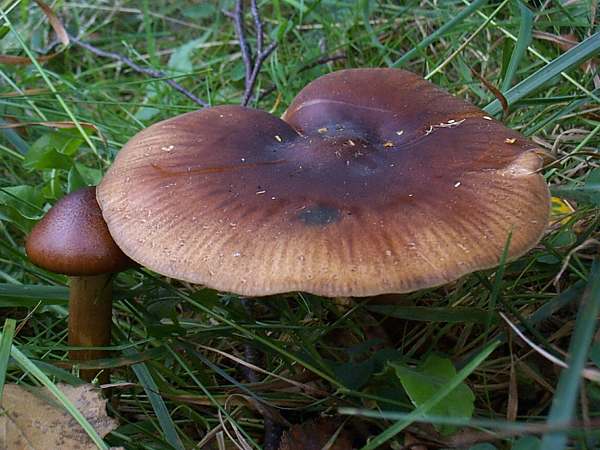
Tricholoma fulvum can grow to 15cm in diameter. Found under deciduous trees, notably birch (hence its common name Birch Knight), the caps expand with a low central umbo, mature caps are radially streaky. It is generally considered a rather poor but edible mushroom.
Birch Knights occur in large numbers on wet woodland edges, but also keep an eye open for these atypical knights where birches have sprung up as pioneer trees on the disturbed boggy land beside low-lying forestry tracks.
Most of the Tricholoma fungi (the 'knights') have white gills, but this is an exception, and with its tendency to develop brown spots on its gills plus the distinctive cap striations the Birch Knight is arguably the most distinctive member of this tricky group of mushrooms.
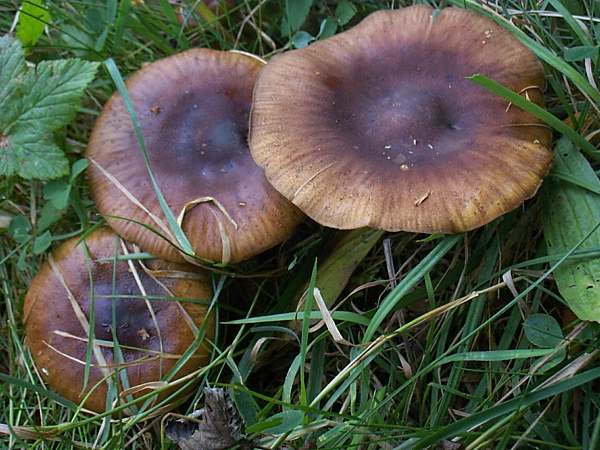
Distribution
This striking mycorrhizal mushroom is very common and widespread throughout Britain and Ireland, and it occurs also in most parts of mainland Europe. Tricholoma fulvum is also recorded occasionally in some parts of North America.
Taxonomic history
There has been much debate over the authority for the Birch Knight. Although this mushroom was described scientifically in 1792 by French mycologist Jean Baptiste Francois (Pierre) Bulliard, who named it Agaricus fulvus, its currently accepted binomial was established as recently as 1913, when French mycologists René Bigeard (1840 – 1917) and Henri Guillemin (biographical dates not known to us) transferred this species to the genus Tricholoma, establishing the binomial name as Tricholoma fulvum.
Synonyms of Tricholoma fulvum include Agaricus fulvus Bull., Agaricus flavobrunneus Fr., Agaricus nictitans Fr., Tricholoma flavobrunneum (Fr.) P. Kumm., and Tricholoma nictitans Fr.) Gillet.
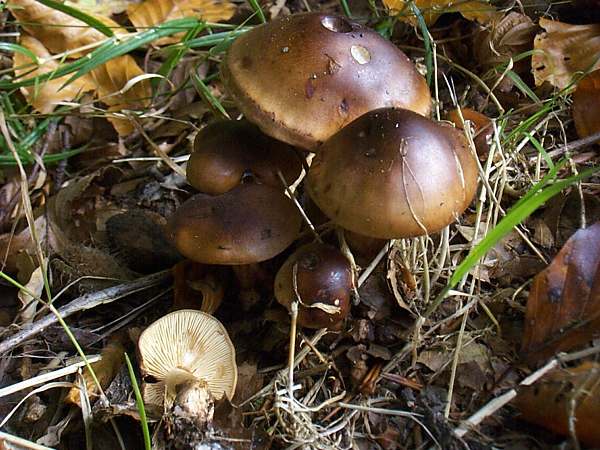
Etymology
Tricholoma was established as a genus by the great Swedish mycologist Elias Magnus Fries. The generic name comes from Greek words meaning 'hairy fringe', and it must be one of the least appropriate mycological genus names, because very few species within this genus have hairy or even shaggily scaly cap margins that would justify the descriptive term.
The specific epithet fulvum comes from Latin and means tawny (yellowish brown).
Identification guide
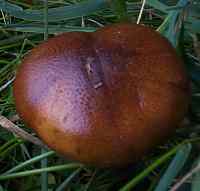 |
CapReddish-brown in the centre, with the margin more yellow and with radial brown streaks; convex, flattening with a small umbo; matt and finely fibrillose; sticky when wet; 5 to 12cm across. |
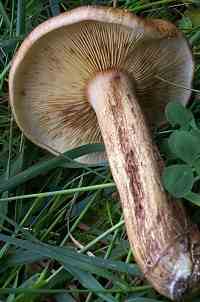 |
GillsBright yellow, becoming marked with brown spots; adnexed. StemPale yellow; lined vertically with brown fibres; cylindrical; fibrous; 5 to 10cm long, 8 to 15mm diameter; no stem ring. |
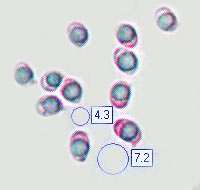 |
SporesSubglobose to oblong, smooth, 5-7 x 4-5μm. Spore printWhite. |
Odour/taste |
Odour slightly farinaceous (like flour dough); taste not significant. |
Habitat & Ecological role |
Ectomycorrhizal with deciduous trees, mainly birches, usually in wet places; occasionally on roadside verges under hedgerows. |
Season |
June (often one of the earliest of the Tricholoma species to appear) to October. |
Similar species |
Tricholoma equestre has a brown-yellow cap but is distinguished by its bright-yellow gills. |
Culinary Notes
Unfortunately, although generally considered edible this large and abundant mushroom is of very poor quality and therefore not worth gathering.
Reference Sources
Fascinated by Fungi, 2nd Edition, Pat O'Reilly 2016, reprinted by Coch-y-bonddu Books in 2022.
Kibby, G (2013) The Genus Tricholoma in Britain, published by Geoffrey Kibby
Dictionary of the Fungi; Paul M. Kirk, Paul F. Cannon, David W. Minter and J. A. Stalpers; CABI, 2008.
Taxonomic history and synonym information on these pages is drawn from many sources but in particular from the British Mycological Society's GB Checklist of Fungi.
Fascinated by Fungi. Back by popular demand, Pat O'Reilly's best-selling 450-page hardback book is available now. The latest second edition was republished with a sparkling new cover design in September 2022 by Coch-y-Bonddu Books. Full details and copies are available from the publisher's online bookshop...

